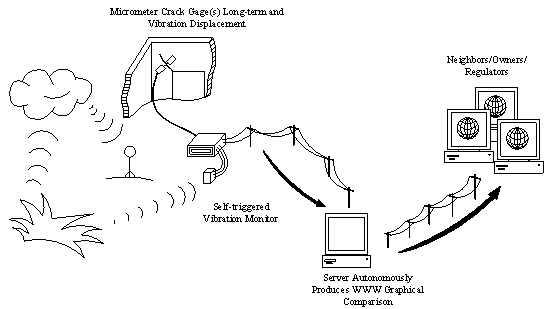|
|
ACM BackgroundBlasting complaints are consuming an increasing amount of time and resources. This worsening situation has spawned new methods for relaying the public's concerns. The direct measurement of crack response to both long term environmental and blast vibration effects with the same sensor exemplifies one new approach, which can be helpful in the process of educating quarry neighbors about the large impact of the environmental changes. This comparison of long-term and vibratory crack response demonstrates that the silent response of cracks to environmental changes is larger than that produced by blasting, which is felt and heard.
Figure 1: Autonomous Crack Comparometer Several varieties of crack monitoring systems are presently employed in locations across the United States. The details of these systems are not as important as is their measurement of crack response. Northwestern University operates two experimental systems with full remote operability and Internet display of information. This system is built around a remotely operable field data acquisition computer (Dowding and Siebert, 2000). This article demonstrates how the use of sensor technology and computerized data acquisition systems can be actively used to address fears of vibration-induced cracking by directly measuring crack response. Relatively inexpensive systems to monitor both crack response and ground motion have been developed that involve the manual down loading of data on a periodic basis. These systems can be combined with telecommunications for autonomous display on the Internet to more directly interact with the public and to add credibility to the data. As described in this article, a previous study using several different systems and sensors showed |
|
